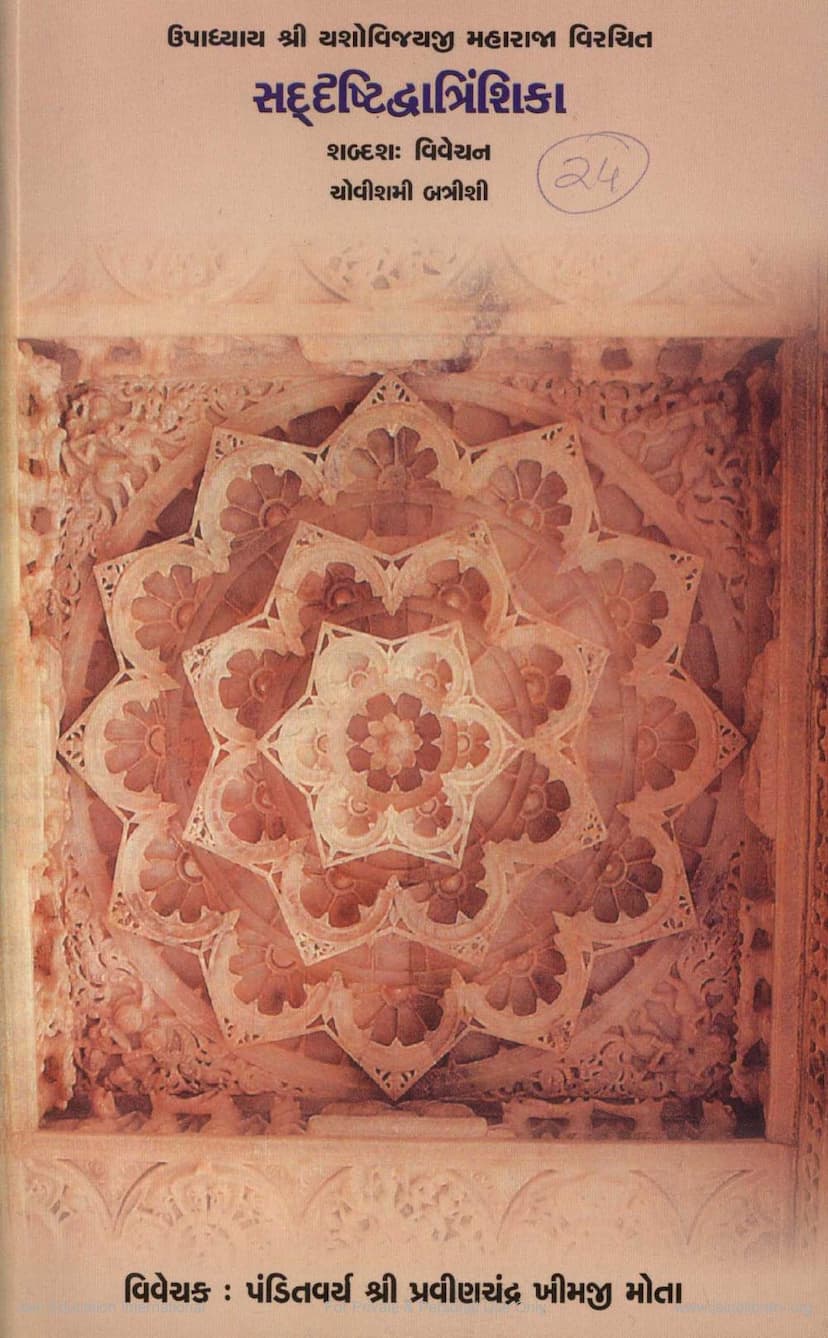Saddrushti Dvantrinshika
Added to library: September 2, 2025

Summary
Here's a comprehensive summary of the Jain text "Saddrushti Dvātrinśikā," based on the provided pages:
Title: Saddrushti Dvātrinśikā (सद्दृष्टिद्वात्रिंशिका) Author of Original Text: Mahamahopadhyaya Shri Yashovijayji Maharaj Commentator/Author of Present Exposition: Panditvar Shri Pravinchandra Khimji Mota Publisher: Gitarth Ganga, Ahmedabad
Overview:
"Saddrushti Dvātrinśikā" is the 24th chapter (Dvātrinśikā) within the larger work "Dvātrimśad Dvātrimśikā" (द्वात्रिंशद्द्वात्रिंशिका) by the esteemed Jain scholar Mahamahopadhyaya Shri Yashovijayji Maharaj. This particular chapter focuses on the "Saddrushti" (सद्दृष्टि) – the Righteous or Correct View/Perspective, which is considered crucial for spiritual progress. The provided text is a detailed, word-for-word commentary (shabdaha vivechan) by Panditvar Shri Pravinchandra Khimji Mota, aiming to elucidate the profound philosophical concepts presented by Yashovijayji Maharaj.
The text is part of a larger initiative by "Gitarth Ganga" to publish and disseminate profound Jain scriptures and commentaries, making them accessible to the Jain community.
Core Subject Matter:
The "Saddrushti Dvātrinśikā" deals with the eight stages of spiritual perception or perspective (Yoga Drishti) that a practitioner progresses through on the path to liberation (Moksha). These stages represent a deepening understanding and refinement of one's spiritual viewpoint, moving from a foundational understanding to the highest realization.
The commentary by Panditvar Mota systematically explains each of these eight perspectives, drawing heavily on the philosophical framework of Yoga as understood within Jainism, and referencing other foundational Jain texts and scholars like Haribhadrasuri.
Summary of the Eight Yoga Drishtis (Perspectives):
The text details the progression through these eight perspectives:
- Mitra Drishti (मित्रदृष्टि): A preliminary stage, characterized by a nascent but unrefined understanding.
- Tara Drishti (तारदृष्टि): A slightly more developed perspective, still with significant impurities.
- Bala Drishti (बलदृष्टि): A stage of developing strength in perception, but still facing challenges.
- Dipa Drishti (दीपदृष्टि): A clearer, lamp-like illumination of truth, capable of showing subtle aspects but still subject to external influences like wind.
- Sthira Drishti (स्थिरादृष्टि): (Detailed explanation in this commentary) This is where the true understanding of reality begins to stabilize. Characterized by the yogic practice of Pratyahara (withdrawal of senses), it leads to a clear, unwavering discernment between what should be accepted and what should be rejected (Heva-Upadeya Viveka). Worldly activities appear trivial, like children playing with dust, because the individual sees the ephemeral and impure nature of worldly pleasures. The true reality appears as pure, luminous, and self-manifest.
- Kanta Drishti (कान्तादृष्टि): (Detailed explanation) This stage involves Dharana (concentration). The perception becomes even more refined and beautiful, attracting others. The practitioner possesses unwavering faith and unwavering concentration on the truth. Worldly pleasures, even if experienced, do not bind them due to a deep understanding of their impermanence and a mind constantly oriented towards the spiritual. They possess insights that can discern the true nature of things.
- Prabha Drishti (प्रभादृष्टि): (Detailed explanation) This stage involves Dhyana (meditation). The perception is luminous like the sun, characterized by profound realization and deep meditation. The practitioner experiences sustained bliss from the soul and engages in "Asanga Anushthan" (action without attachment). They possess immense clarity and are described as having attained a state of "Samprvritipda" (a state of ideal conduct/practice).
- Para Drishti (परादृष्टि): (Detailed explanation) This is the highest stage, involving Samadhi (deep, integrated meditation). The perception is supreme and unwavering. The practitioner attains a state of complete detachment from worldly attachments and even from the subtle nuances of the spiritual path itself. This stage leads to the realization of the true self, the eradication of all karmic bonds, and ultimately, the state of liberation. The text details how practitioners in this stage are "Nirachara Pad" (without the need for specific prescribed actions) because their inner purity transcends external rituals. Their actions are effortless and aligned with their supreme realization, leading them to Kevalajnana (omniscience) and ultimately Moksha.
Key Concepts and Themes:
- Progression of Spiritual Insight: The eight Drishtis represent a progressive journey of spiritual understanding and realization.
- Yoga Angas: The stages are often correlated with the development of various limbs of Yoga (e.g., Pratyahara, Dharana, Dhyana, Samadhi).
- Discernment (Viveka): The ability to distinguish between the real (Atman) and the unreal (non-Atman, worldly phenomena) is central to the lower stages.
- Detachment (Asanga): As one ascends, detachment from worldly pleasures and even from subtle spiritual concepts becomes paramount.
- Impermanence of Worldly Pleasures: The text emphasizes that worldly pleasures are like illusions or snakes' hoods – attractive but ultimately leading to suffering.
- Role of Knowledge and Faith: Right knowledge (Samyag Jnana) and right faith (Samyag Darshana) are foundational for developing these perspectives.
- Critique of Mere External Renunciation: The commentary clarifies that mere external renunciation without inner transformation is insufficient. True liberation comes from inner purification and detachment.
- The Nature of Happiness: True happiness is understood as self-contained and independent of external factors ("Atmavasham Sukham"), unlike worldly pleasures which are perceived as dependent and therefore ultimately sorrowful ("Paravasham Dukkham").
- Subtlety of Karmic Action: Even actions performed with spiritual intent can have subtle karmic implications if not perfectly aligned with the highest truth or if accompanied by subtle attachments.
Commentary Style:
Panditvar Mota's commentary is meticulous, providing word-for-word explanations of Yashovijayji's verses. He clarifies complex philosophical terms, provides analogies, quotes other scriptures (like Patanjali's Yoga Sutras), and offers detailed interpretations to ensure the profound meaning of the original text is understood by the reader. The commentary aims to be comprehensive and resolve any potential doubts.
Significance:
"Saddrushti Dvātrinśikā" is a vital text for Jains seeking to deepen their spiritual understanding. It provides a clear roadmap for developing the correct perspective, which is essential for dispelling ignorance, overcoming attachments, and progressing on the path to liberation. The detailed commentary makes this complex subject accessible and guides the aspirant towards a profound appreciation of the Jain path.